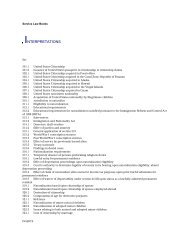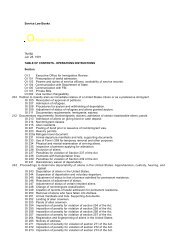Create successful ePaper yourself
Turn your PDF publications into a flip-book with our unique Google optimized e-Paper software.
<strong>Inspector's</strong> <strong>Field</strong> <strong>Manual</strong><br />
The applicant must establish Canadian citizenship.<br />
The I-129 petition may be filed (in duplicate) by the U.S. or foreign employer in advance of entry or in<br />
conjunction with an application for admission. When filing in advance, the petition should be submitted to the<br />
appropriate Service Center at least 30 days in advance of the expected date of entry. The applicant must present<br />
evidence of the approved petition at the time of application for admission. If the petition is filed with an<br />
application for admission, such filing must be made with an immigration officer at a Class A port-of-entry<br />
located on the US-Canada land border or at a U.S. pre-clearance/pre-flight station in Canada. The petitioning<br />
employer need not appear, but the Form I-129 must bear the authorized signature of the petitioner and all<br />
documentation and the appropriate filing fee must accompany the petition.<br />
(B) Citizens of Mexico. A citizen of Mexico must apply for an L visa at an American consulate. At the<br />
port-of-entry, the applicant must present a valid Mexican passport with their L-1 visa.<br />
(3) Spouses and Dependent Children. Spouses and dependent children of intracompany transferees<br />
may accompany or follow to join the L-1 principal if they otherwise meet the general immigration requirements<br />
for temporary entry. L-2 is the designated classification for both spouse and dependent children of<br />
intracompany transferees. There is no requirement that the spouse and dependent children be citizens of Canada<br />
or Mexico. L-2 dependents who are citizens of Canada are not required to obtain an L-2 visa but may seek visa<br />
issuance if desired. L-2 dependents who are citizens of Mexico or other countries generally are required to seek<br />
visa issuance. L-2's may not work in the United States. L-2's may attend school while in the United States<br />
incident to their temporary stay.<br />
(f) TN Classification as a Professional.<br />
(1) General. The NAFTA professional is unique to the Agreement and the classification is not found in<br />
general immigration provisions in section 101(a)(15) of the Act, rather, it is included in section 214(e). Under<br />
NAFTA, a Canadian or Mexican citizen who seeks temporary entry into the United States as a professional may<br />
be admitted to the United States under the provisions of the NAFTA as a TN (for Trade NAFTA). The TN is<br />
limited to Canadian or Mexican professionals employed on a professional level. A professional is defined as a<br />
business person seeking entry to engage in a business activity at a professional level in a profession set forth in<br />
Appendix 1603.D.1 to Annex 1603, if the business person otherwise qualifies under existing, general<br />
immigration requirements for temporary entry to the United States [See Appendix 15-4 of this manual for Annex<br />
1603, Appendix 1603.D.1.] [For regulations relating to NAFTA TN classification, refer to 8 CFR 214.6.].<br />
The NAFTA professional is modeled on the professional category in the predecessor trade pact, the United<br />
States-Canada Free-Trade Agreement (CFTA), which was in effect from January 1, 1989 until the entry into force<br />
of the NAFTA on January 1, 1994. The provisions differ slightly for Canadian citizen applicants and Mexican<br />
citizen applicants. Presently, the number of Mexican citizens entering the United States as TN professionals<br />
under NAFTA is limited to 5,500. There is no numerical limitation on the number of Canadian citizen TN<br />
professionals.<br />
As with the CFTA, admission as a TN under section 214(e) of the Act does not imply that the citizen of Canada<br />
or Mexico would otherwise qualify as a professional under sections 101(a)(15)(H)(i) or 203(b)(3) of the Act.<br />
Note too that Section D of Annex 1603 does not authorize a professional to establish a business or practice in the<br />
United States in which the professional will be self-employed. Canadian or Mexican citizens seeking to engage<br />
in self-employment in trade or investment activities in the United States must seek classification under section<br />
101(a)(15)(E) of the Act.<br />
(2) Appendix 1603.D.1 to Annex 1603 of the NAFTA. Under NAFTA, an applicant seeking<br />
classification as a TN must demonstrate business activity at a professional level in one of the professions or<br />
occupations listed in Appendix 1603.D.1 to Annex 1603. Appendix 1603.D.1 (which replaces Schedule 2 to<br />
Annex 1502.1 of the CFTA) is set forth at 8 CFR 214.6(c). A Baccalaureate (bachelor's) or Licenciatura degree is<br />
the minimum requirement for these professions unless an alternative credential is otherwise specified. In the<br />
case of a Canadian or Mexican citizen whose occupation does not appear on Appendix 1603.D.1 or who does not<br />
meet the transparent criteria specified, nothing precludes the filing of a petition for classification under another<br />
existing nonimmigrant classification.<br />
A footnote to Appendix 1603.D.1 allows for temporary entry to perform training functions relating to any of the




